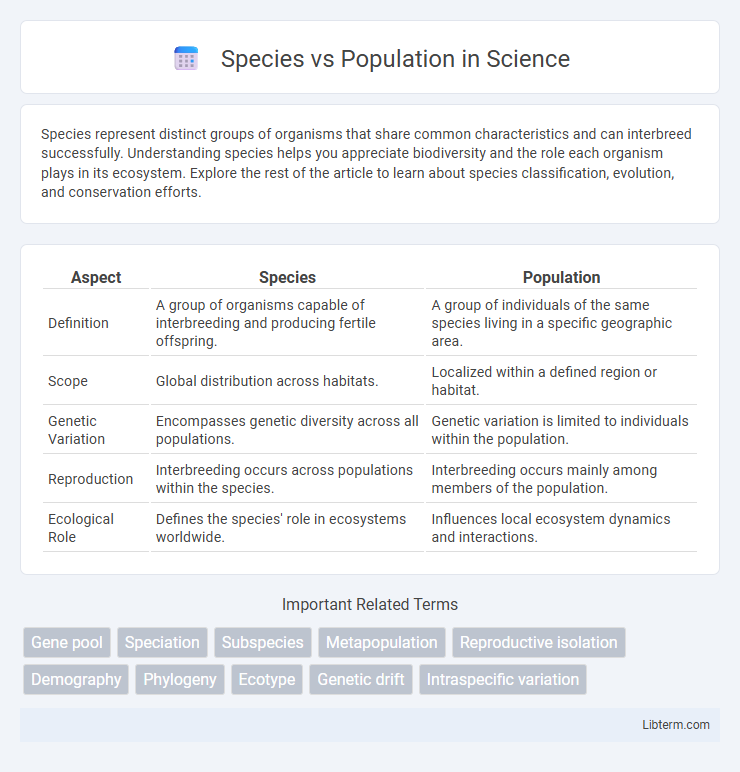Species represent distinct groups of organisms that share common characteristics and can interbreed successfully. Understanding species helps you appreciate biodiversity and the role each organism plays in its ecosystem. Explore the rest of the article to learn about species classification, evolution, and conservation efforts.
Table of Comparison
| Aspect | Species | Population |
|---|---|---|
| Definition | A group of organisms capable of interbreeding and producing fertile offspring. | A group of individuals of the same species living in a specific geographic area. |
| Scope | Global distribution across habitats. | Localized within a defined region or habitat. |
| Genetic Variation | Encompasses genetic diversity across all populations. | Genetic variation is limited to individuals within the population. |
| Reproduction | Interbreeding occurs across populations within the species. | Interbreeding occurs mainly among members of the population. |
| Ecological Role | Defines the species' role in ecosystems worldwide. | Influences local ecosystem dynamics and interactions. |
Defining Species and Population
Species represent groups of organisms that can interbreed and produce fertile offspring, sharing common genetic and morphological traits. Population refers to a subset of a species, consisting of individuals living in the same geographic area and interacting actively. Understanding the distinction between species and population is essential for ecological studies, conservation efforts, and evolutionary biology.
Key Differences Between Species and Population
Species represent groups of organisms capable of interbreeding and producing fertile offspring, defined by shared genetic traits and evolutionary history. Populations are localized groups of individuals within a species, inhabiting a specific geographic area and interacting through breeding and resource competition. Key differences include the scope of genetic diversity, with species encompassing broader genetic variability across multiple populations, while populations exhibit genetic variation influenced by environmental factors and geographic isolation.
Biological Importance of Species
Species represent the fundamental units of biological classification and biodiversity, defining distinct groups of organisms capable of interbreeding and producing fertile offspring, which ensures genetic continuity and adaptation. Populations are subsets within species, consisting of individuals occupying specific habitats and interacting in gene flow, but species encapsulate the broader evolutionary and ecological significance. Conserving species is crucial for maintaining ecosystem stability, resilience, and evolutionary potential across varied environments.
Population Dynamics Explained
Population dynamics explore changes in population size, density, and structure over time within a species, influenced by birth rates, death rates, immigration, and emigration. Key factors include resource availability, environmental conditions, and interactions like predation and competition, which drive fluctuations in population growth or decline. Modeling population dynamics with tools such as the logistic growth model or Lotka-Volterra equations provides insights into species survival, ecosystem stability, and biodiversity conservation.
Genetic Variation in Species vs Population
Genetic variation in a species encompasses the total genetic diversity found across all populations of that species, reflecting differences in alleles and genotypes among individuals. Within populations, genetic variation tends to be lower due to localized breeding and shared gene pools, which can lead to more homogeneity. Understanding the distribution of genetic variation at both species and population levels is crucial for conservation genetics and managing biodiversity effectively.
Interactions Within Species and Populations
Interactions within species occur primarily through behaviors such as competition for resources, mating, and social hierarchies, which shape population dynamics and genetic diversity. Populations, defined as groups of individuals of the same species living in a specific area, experience varying degrees of interaction that influence reproductive success and survival rates. Understanding these interactions is crucial for studying ecological balance, natural selection, and evolutionary processes within species.
Ecological Roles of Species and Populations
Species serve as fundamental ecological units characterized by shared genetic traits and the ability to interbreed, shaping ecosystem diversity and stability through their unique roles such as pollination or predation. Populations represent groups of individuals of a species within specific habitats, influencing factors like resource competition, gene flow, and population dynamics that determine community structure. The ecological roles of species provide the broader functional traits in ecosystems, while populations affect localized interactions and adaptability, together maintaining ecosystem resilience and biodiversity.
Factors Affecting Population Structure
Population structure is influenced by factors such as birth and death rates, migration patterns, and genetic variation within the population. Environmental conditions like resource availability, habitat fragmentation, and predation pressure directly affect population density and age distribution. Human activities, including urbanization and pollution, also play critical roles in altering population dynamics and genetic diversity.
Conservation Implications: Species vs Population
Conservation strategies prioritize species as the fundamental units for legal protection, yet population-level management is crucial for maintaining genetic diversity and adaptive potential within species. Protecting distinct populations helps prevent local extinctions and supports ecosystem resilience by preserving unique genetic traits and allowing for natural evolutionary processes. Effective conservation plans integrate species-level protection with targeted efforts to sustain viable populations across their geographic ranges, enhancing overall biodiversity preservation.
Case Studies Illustrating Species and Population Concepts
Case studies from Galapagos finches demonstrate species diversity through variations in beak shape adapted to different ecological niches, highlighting speciation processes. Research on African elephants reveals population dynamics by tracking genetic diversity within isolated groups, emphasizing conservation needs for maintaining viable populations. Studies on coral reef fish populations show how habitat fragmentation impacts gene flow, providing insight into both species differentiation and population structure.
Species Infographic

 libterm.com
libterm.com